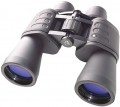Field of view 1 km away
The diameter of the area visible through binoculars / monoculars from a distance of 1 km — in other words, the largest distance between two points at which they can be seen simultaneously from this distance. It is also called "linear field of view". Along with the angular field of view (see below), this parameter characterizes the space covered by the optics; at the same time, it describes the capabilities of a particular model more clearly than data on viewing angles. Models with magnification adjustment (see above) usually indicate the maximum field of view — at the lowest magnification and
the widest angle of view. This information is often supplemented by data on the minimum value.
Real angle of view
The section of the panorama that can be viewed through the eyepieces of binoculars. The higher the actual angular field of view, the wider the visibility of the optics. Note that the angular field of view has an inverse relationship with magnification. That is, the higher the magnification, the narrower the visibility (the smaller the real angular field of view). The actual angular field of view is calculated as follows: you need to divide the angular field of view (in degrees °) by the magnification factor. In comparison, the human eye has an angular field of view of 60 arcseconds (“). In terms of degrees, you get 150 °. Good binoculars provide a real field of view somewhere within 10 arcseconds. But it does not always make sense to chase after large indicators of the real angular field of view. The fact is that when viewing a large section of the panorama, the edges of the image receive noticeable distortion.
Min. focus distance
The smallest distance to the observed object, at which it will be clearly visible through binoculars / monoculars. All such optical instruments were initially created for observing remote objects, therefore, not all of them are able to work at short distances. When choosing a model for this parameter, one should proceed from the expected observation conditions: ideally, the minimum focus distance should not be greater than the smallest possible distance to the observed object.
Diopter correction range
The range of values in which diopter adjustment can be made (see above). If you wear glasses with diopters, but plan to look through binoculars / monoculars without them, you should choose a model whose range would correspond to the characteristics of the glasses (or at least be as close as possible to them).
Prism material
Material used for prisms found in binoculars and monoculars.
-
BK-7. A type of borosilicate optical glass (6LR61), a relatively inexpensive and at the same time quite functional material that provides, although not outstanding, quite acceptable image quality. Used in entry-level and mid-level models.
—BaK-4. Barium optical glass, noticeably superior to BK7 in brightness and image clarity, is however also more expensive. Accordingly, it is found mainly in the premium segment.
Interpupillary distance
Interpupillary distance adjustment range provided in binoculars with the corresponding function.
Recall that, ideally, the interpupillary distance of the device should correspond to the distance between the centers of the pupils of the user himself. With this calculation, it is worth choosing binoculars according to this parameter; and if the device will be used by several people, it is worth making sure that they all “fit” into the adjustment range of the selected model. However, not every person knows exactly their interpupillary distance, especially since it changes with age; and the circle of users can be indefinite — for example, if we are talking about "rolling" binoculars in the hunting industry. In such cases, it is worth proceeding from the following.
In adults of more or less standard physique, the interpupillary distance is in the range from 60 to 66 mm. Modern binoculars cover this range with a margin — even the most modest models support values from 60 to 70 mm, and in most cases the lower limit of the range lies in the region of 54 – 57 mm, and the upper one — 72 – 75 mm. This is quite enough for most adults, including those with a non-standard physique — miniature, or vice versa, large. So a wider range may come in handy only in special cases. For example, if a child will use binoculars, it is desirable that the lower adjustment limit be lower than the standard 50 – 55 mm (in some models, this limit is at the level of 38 mm, or even 34 mm).

